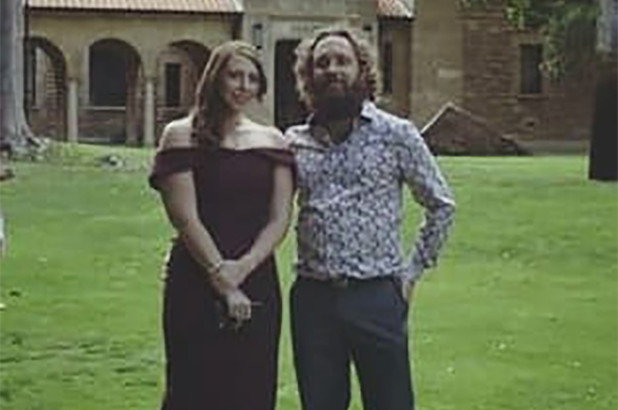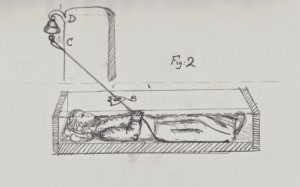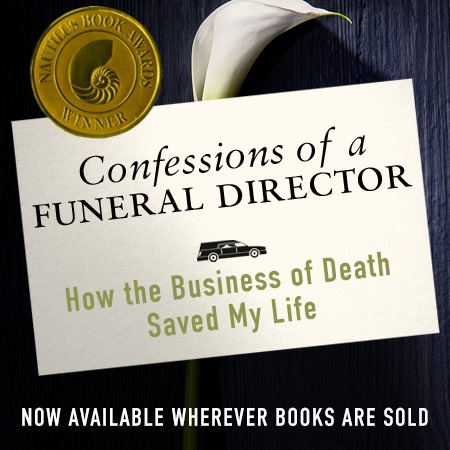Death in the News
An “exploding dead body”, a “coerced cremation” and a lawsuit

Here’s the story:
A Montana mortuary business must pay a woman $50,000 after her husband was cremated against his wishes.
The Great Falls Tribune reports a jury found a mortician at Miser Mortuaries in Conrad negligent in the decision to cremate 64-year-old Robert Yeager of Ulm after he died of liver and heart disease in October 2012.
Enid Yeager told jurors that mortuary staff pushed her toward cremation because the larger casket needed to bury her husband would be costly.
Miser’s attorneys said mortician John Nash simply recommended Robert Yeager be cremated because he couldn’t have an open casket funeral due to the swollen condition of his body. Nash said Enid Yeager signed off on having him cremated.
Jurors on Wednesday found both the mortuary and Enid Yeager partially liable. She had sought $1 million in damages. — The New York Times
All in all, I like the ruling. We all like black and white cases, but this one is painted in grey. I don’t think this was a matter of maliciousness on the part of either party, but rather a communication problem, a problem that rests more heavily with Mr. Nash.
Here are some more details that help flesh out the case:
The conflict of this case was borne out of the complications in burying Robert in a casket: he died of liver and heart disease and, as a result, had grown considerably swollen with fluids shortly before and after his death. Court records and testimony included mention of splitting skin, building gases and leaking liquids.
He would have fit in an oversized casket, Miser’s mortician claimed to have told Yeager. But she alleged the funeral home staff pushed her toward cremation because the oversized casket would be very costly, and he “could not have a casket ceremony” because her husband’s body “would explode.” — Great Falls Tribune
I don’t know about you, but I wouldn’t mind my body exploding at my funeral. In Oprah voice, “Everyone get’s a piece of Caleb. You get an arm! You get a leg!”
Who am I kidding, though. Nobody has ever wanted my body.
The funeral business rests on the principle that we exist to serve you … within reason.
Having an open casket viewing for a deceased person who is in the early part of active decay generally not within reason (how he got to this point is the question I’d like to know. I digress.). For those of you who have been around a decomposing body, you know of the troubles in which I speak. We’ve all smelled roadkill in the hot months of summer. That smell is tacos to human decompositions surströmming. Humans just smell the worst. The last thing you’d want is an open casket viewing for a decomposing body. It would literally be nauseating for everyone who came to the funeral with a sense of smell.
However, if you can’t have an open casket viewing, cremation generally isn’t the next step down on the ladder of options. A closed casket with the body present is the next step down the options ladder.
Why did Mr. Nash suggest cremation instead of a closed casket? I suspect that the underlying and unspoken crux of this, specifically as it relates to the funeral home, may have had less to do with the troubles that come with a decomposing body and more to do with two other things:
1.) Money.
I find it interesting that the reports specifically mention that Mr. Yeager needed a larger casket for his swollen body, a casket that would have cost more money … perhaps significantly more money. Larger caskets often necessitate larger vaults, and larger vaults demand more grave digger costs, all of which can easily incur an added $1,000 to $3,000 in cash advances, half of which is associated with the cemetery.
Funeral directors often tend to suggest less expensive options … like cremation, especially if funds are limited. And there’s nothing wrong with suggesting a less expensive option. I do it all the time. In fact, I usually tell the family that I’m going to show them the least expensive options first, and then they can go from there.
2.) Communication.
This is where the problem happened. Obviously. Mrs. Yeager wanted something. Mr. Nash didn’t entirely hear her. Or, Mrs. Yeager wasn’t able to express it well enough for Mr. Nash to hear her because she had “grief brain.” But, Mr. Nash should have recognized her “grief brain” and listened a little more deeply.
Look, I don’t think Mrs. Yeager is sue-happy and just wanted to get a quick mil from the funeral home. I think she is genuinely hurt and upset. And she has every right to be.
I also don’t think Mr. Nash the funeral director was out to get Mrs. Yeager. I have no doubt he had good intentions.
What I do know is this: Funeral directors (and this includes me) need to learn to practice deep listening and mindfulness. In fact (and I’m talking to us funeral directors), if you notice yourself unable to practice deep listening, it’s time for a sabbatical. Or it’s time to find another job (there’s no shame in quitting … too many funeral directors stay in this business far past their expiration date … and there’s an expiration date for EVERY career).
For those of you in the business, here are some mantras you’ve likely heard:
“Mindfulness over money.”
And.
“Service over sales.”
You know those by heart. But here’s a level two funeral service mantra:
“Listening over talking.”
Because, for us as funeral directors, if we want to serve well, we have to deeply listen.
*****
If you like my writing, consider buying my 2017 Nautilus Book Award Gold Winner, Confession of a Funeral Director (click the image to go to the Amazon page):
About that couple that fell off a cliff while they were taking a selfie (boring thoughts only a funeral director would think of)

via facebook
News stories like this are absolutely horrible. The emotional toll that these deaths will have on their family and friends will be debilitating on multiple levels. You just don’t recover from this type of news.
As a funeral director, though, I look at such a situation through a different lens, especially since this couple weren’t Portuguese natives.
These are the initial reports:
Australian Michael Kearns, 33, and his British girlfriend Louise Benson, 37, were standing on a wall overlooking the picturesque Praia dos Pescadores beach in Ericeira early Tuesday, when their phone slipped, Perth Now reported.
Authorities think the pair reached out to grab the cellphone, lost their balance and fell 98 feet to the rocky beach below. — Via New York Post
Fishermen discovered the bodies and reported that it was like a “horror scene” and that the couple’s bodies were “shattered.”
At our funeral home, we only tend to handle international ship-outs or ship-ins about every other year. Most of the people in the Parkesburg area are local. They’re the type of locals who rarely travel across the Mississippi, and hardly ever travel across the Atlantic or the Pacific.
Unless you’re a funeral home that deals specifically with a certain demographic (maybe a city funeral home whose main clientele are Greeks who want to be shipped back to Greece when they die), most funeral homes — like ours — aren’t experts in international shipping of human remains. Why?
*****
BECAUSE EVERY COUNTRY IS DIFFERENT. Almost all countries require the body to be shipped back to the homeland in what’s called a hermetically sealed (airtight) shipping container so that no fluids leak out during transportation OR sometimes you can bypass the hermetically sealed container if the body is embalmed (fun fact: when you fly, there’s a chance a corpse is being shipped in the cargo bay). For the US, the corpse either has to be in a sealed container or embalmed.
Sometimes the cause of death has to be determined before shipment can take place because if the death was caused by an infectious disease, shipment is much less likely to take place. And as you may know, the cause of death for accidental or suspicious deaths can take weeks to determine, leaving the family of the deceased waiting and waiting and waiting for the shipment to take place.
THE PAPERWORK IS A MILE HIGH. For Michael Kearns and Louise Benson, their bodies are subject to both Portuguese rules and regs, AND British and Australian rules and regs. For most of us in the funeral business, the paperwork for international ship-outs can be so difficult (often times you have to know the right people at the Embassy) we contract it out to a company that deals solely with international ship outs.
Often times, the official approval from the receiving nation can itself take weeks. In other words, the bodies of Michael and Louise might have to extend their stay.
THE MONEY. To have a body shipped to the US will generally cost somewhere around $5,000, but it often tends to be more. I have a Greek friend who shipped his son back to Greece for a cost of $20,000 (this wasn’t through our funeral home).
CREMATION IS USUALLY THE CHEAPEST AND LOGISTICALLY EASIEST OPTION. If you can stomach it. The problem with cases like Michael and Louise is that — at least for tragic deaths — the family usually wants to see the body. There’s this nagging feeling that “he/she just can’t be dead. I don’t believe it.” And the only way they can confirm that it’s actually true is to see the deceased with their own two eyes. That desire makes cremation a tough choice.
SHATTERED BODIES. This is just such a tough case for the families. Not only are they dealing with sudden and tragic deaths of their loved ones in another country, but their bodies are wrecked.
*****
IT’S NOT A LAUGHING MATTER: Here’s the problem with the word “selfie”, specifically as it relates to Michael and Louise. Pamela B. Rutledge Ph.D. writes, “Selfies frequently trigger perceptions of self-indulgence or attention-seeking social dependence that raises the damned-if-you-do and damned-if-you-don’t specter of either narcissism or low self-esteem… If the people in selfies aren’t famous or being paid to pose, then it must indicate a moral failing and they are labeled bragging, attention seeking, self-focused or narcissistic” (Via Psychology Today).
I don’t think Michael and Louise’s death would have made the news if they simply fell to their deaths. But because they fell taking selfies, it almost humorous or at least a moral lesson. Because they died taking selfies, the perception is that it diminishes their deaths … that we can snicker at their deaths like we’d snicker at a drunk who walked in front of a train.
But it’s not funny. And their deaths shouldn’t be diminished. What their families will go through over the next week or so will be absolutely horrible as they negotiate what they need to do.
*****
*****
If you like my writing, consider buying my 2017 Nautilus Book Award Gold Winner, Confession of a Funeral Director (click the image to go to the Amazon page):
What It’s Like Embalming a Child Killed by Gun Violence

Another school shooting. Ten people died, nine students. This is the 22nd school shooting since the beginning of 2018. The 22nd in just over five months. Let that sink in.
At this point, we’re tired of it, tired of it happening, tired of hearing about it, and tired of the polemics. So maybe a perspective from a funeral director and embalmer can help scratch off the callous. As a forewarning, the content in this post will be disturbing as I present the problems embalmers face with gun wounds.
I was told in funeral school that funeral directors should never, under any circumstances, divulge their political opinions. “Unless you want to lose business,” my prof told us during the fall of 2004 when the Kerry Vs. Bush political battles were headlining, “keep your politics out of death care. Death is about unity, goodwill, and grace. Politics is the exact opposite.”
My prof was right on both accounts. I write in my book how death allows us to transcend our little groups and see the bigger picture, namely that at our core, we may be Democrat or Republican, black or white, gay or straight, but we’re also fundamentally human. Our distinctives are important and should never be minimized, but death gives us a little reprieve from the unneeded tension because it allows us to focus on the things that bind us together, not the things that divide us. Remember 9/11? Remember how we joined together for a month or so, united?
There’s a time for political action, and as I’ve argued before … if grief is the basis for someone’s action, it’s not our job to lecture that activist because — although death can be a classroom — you are NEVER the teacher. Simply: our job as outsiders is to give the grieving a refuge, not put them in a classroom.
While funeral directors rarely get political, that doesn’t mean we don’t get involved. Seventy-one-year-old Ronald Jones, a funeral director from St. Louis was tired of burying kids killed by gun violence, so he finds at-risk youth on the streets and mentors them.
This from an interview with Mr. Jones, a piece that captures what funeral directors experience when a death is by gun violence and the family wants some restoration:
Many times Jones said he’s recognized people that he’s cared about come across his (prep room) table. Nearly seven years ago, he lost someone that he had mentored for years. To this day, Jones still refers to her as one of his “kids.” She was shot 11 times. The bullet wounds left her face mutilated and her skull shattered. When he saw her, Jones didn’t even recognize her.
It took him a few days just to sew up all of the entrance and exit wounds to her face, and he had to use 254 pieces of wire to reconstruct her skull. But as he got closer to making her whole again, things started to become a lot clearer.“When I pulled the face over the skull, I almost fell out on the floor, because I’m recognizing somebody that I know and was dear to me,” Jones said. “So I was mandated to really do my best to bring her back so her baby and aunt who raised her could bring some closure.”
Even though funeral directors are rarely political, we often see the outcome of violence, on both a physical and psychological level. We put together faces, and we attempt to put together the funerals for those faces. Seeing that, touching that, stitching that back together … it does something to a person. I can’t exactly say what it does except that it makes the world’s problems seem so much larger and so much more difficult.
What is it like putting faces back together? Well, it depends.
Either today or tomorrow, the parents and the families of the Santa Fe shooting victims have to make this decision: do we want to have a public viewing for our daughter/son’s body, or not?
As the details of the shooting were coming out, I was particularly struck by the fact that the Santa Fe High School shooter used a handgun and a shotgun. From a number of accounts, it seems the shotgun was his weapon of choice. If so — like an assault rifle as well — a shotgun can create a variety of difficulties for an embalmer trying to restore the child.
If I’m a parent, and a public viewing with embalming/restoration is something I want, I’m hoping that my child was one of the ones killed by a handgun (the shooter used a .38 revolver).
I’ve buried a number of people who died from both shotgun wounds and handgun wounds, and there are three general categories of possibilities for a death by firearm, and some different embalming methods we’d likely have to use for each. One or more of these methods would need to be employed for any child shot in a school shooting:
One: SHOT TO THE HEAD: A handgun will have a small entry point and a slightly larger exit point (assuming it exits the body). A person can shoot themselves point blank in the skull and most of the time, the entry point is a little smaller than a penny. That’s usually a simple job for us to fix. Some basic cosmetology and you can hardly tell where the bullet entered.
A shotgun is completely different. Depending on how close the shooter is to their target, a shotgun spray can disfigure a person’s body, especially the face.
Assuming the family wants to see the body, funeral directors have to be honest with ourselves, “Can we reconstruct the severe trauma? Can we make this look somewhat normal?” If the facial features have been ripped off, usually the answer is “no.”
If the shot was to the back of the head, the skull is likely fragmented, but as long as the spray didn’t exit through the front of the face, we can piece the skull back together, or reconstruct the skull through a variety of options.
Two: BODY SHOT: No biggie. A body shot might damage the arterial system, but it’s unlikely that it’d do any more damage than an autopsy, which is something embalmers encounter on a regular basis. In fact, many states require a full autopsy for any suspected homicide, which would mean the heart — the center for arterial distribution of the embalming fluid — would likely be removed for examination. Multi-point injections are a rather regular occurrence for embalmers. A body shot is the best case scenario if the family wants their child to have a public viewing.
Three: MULTIPLE SHOTS TO HEAD AND BODY: If the head and body have sustained multiple shots, the embalming process is much more complex as we have to raise injection sites on the body for specific locations. In Sandy Hook and Parkland, Flordia, the shooters used assault rifles, which resulted in many of the victims being shot numerous times with higher velocity bullets. Multiple shots from an assault rifle, depending on where they hit and what caliber bullet can cause significant trauma to the head and body, making embalming and restoration much more technical, if not impossible.
If the parents want their child embalmed for a viewing, it falls on us to do our best, and be honest with the family if it’s an impossibility. Some embalmers will be putting countless hours into restoration to make the Santa Fe children look as much like they did before they got shot at their school.
And when all is said and done, the best job they can do might still not be perfect. But this is violence, this is a tragedy and perfect disappeared as soon as the shooter starting pulling the trigger.
At this point, most articles about school shootings end with an action point or a political sound byte. I’m a funeral director and embalmer. I’m not supposed to get political. I can’t tell you how to fix the problem, all I can say is that I wish we never had to fix the fractured faces and bodies of school children. I wish we never had to hear mothers and father weep. I wish we never had to … but we do.
*****
If you like my writing, consider buying my 2017 Nautilus Book Award Gold Winner, Confession of a Funeral Director (click the image to go to the Amazon page):
On Death and Humor, and White House aide Kelly Sadler joking about John McCain’s Death

Imagine you’re a neanderthal. You’ve yet to develop language, and your other communication skills are pretty primitive. Now imagine you’re hunting in the woods with your Winchester Model 70 Featherweight (they had those back then).
All of a sudden you bump into something and your “fight or flight response” is activated. Should I point my gun at whatever this thing is, or should I run away, yelling at the top of my lungs? It turns out, that the thing you bumped into is, in fact, another neandertal from another part of the city (those were a thing too). You point your gun (because that’s your first reflex) and they other neanderthal points his at you. You can’t speak, but instead of shooting each other you break out into laughter. Because laughter has always been a way to disengage the fight or flight response, and it’s thought to predate language. Laughter calms things down. It’s an actual scientific factoid.
It even calms things down around death and dying, which is why you’ll often hear jokes and laughter at funerals, or in other death situations. It helps calm the mind from fear, grief and other things that cloud our thinking when we’re confronted with the reality of mortality.
*****
A couple months ago we had a death call at a person’s home. We got there and there was tension in the air. One side of the family was in the house with the decedent, while the other side had been forced outside of the house. The family inside had four bodyguards standing at the door in case the outsiders tried to go in and see the deceased one last time.
When I got inside the house, I was asked — because apparently, I look both nice and stupid — if I could go outside and try to calm the outsiders down. I told the family inside the house that I’d do it if they allowed those outside the house to view the deceased as I removed her out to our van.
“Fine,” they said.
I went outside and brokered the deal: you guys outside can view the deceased when I take her out of the house just as long as you don’t try to force yourselves into the house.
“Deal,” they said.
When I came back inside, the family asked me if they agreed to the terms.
I looked the husband in the eye and told him we solidified the deal by drinking a round of Jack Daniels.
It really wasn’t a funny joke. But because our brains crave the calm of a good laugh when things are stressful, the whole room erupted in laughter. The tension broke. Instead of anger, there were tears. And instead of fighting, even a hug.
Is a joke really that powerful?
Yes. Yes, it can be.
And that power can go both ways. A well-timed, well-intentioned joke can, in the right circumstances, can be a force for good.
In other circumstances, it can do the exact opposite. This is the case for Kelly Sadler.
*****
Here’s the low-down if you haven’t been following the news. I should note that her comment has been hedged by calling it an in-the-moment joke:
Kelly Sadler, a communications aide in President Trump’s administration, reportedly said during a meeting Thursday that Sen. John McCain’s opposition to CIA nominee Gina Haspel “doesn’t matter” because “he’s dying anyway.”
I started to pay rather close attention to politics around Clinton’s second term. By the time Bush v Gore rolled around, I was hooked on the political soap opera. For about five years I studied political theory in my spare time, browsing through the old stuff from The Federalist Papers to Locke’s work, and even writing about it (essays that I would never, ever share publically). Today, I stay up-to-date on the political world, have my opinions, but generally stay away from the fray.
Politics have been tense for as long as I’ve known them. But they’ve never been tenser (and yes, I looked it up … it’s “tenser” and not “more tense”) than they are right now. It’s. Hot. No two words in America (and maybe even the world) are more divisive than “Donald” and “Trump.” For those who support him and those who don’t, those words have separated friends, families, and neighbors in the real world. There are a lot of thoughts and feelings. In the world of social media, both sides of the political spectrum have objectified the “other side” to the place that we no longer view “them” as people, but as “enemies of the American way.”
I used to think funeral homes held a lot of tension, but there’s clearly another house on 1600 Pennsylvania Ave. that holds more. Kelly Sadler works there. She’s staff there. I know what it’s like to work in a tense environment.
Let me be clear, there’s nothing wrong with making jokes about mortality. Everyone in my family jokes about their own and each other’s mortality. Even my grandfather — who is likely closest to his end in our family — gives and receives some funny lines about his future.
But, there are two general rules I follow when I make death jokes: intent and proximity.
One. I always mean well when I make a joke in a death context. It might be to break the ice, to calm the bereaved, or to just make someone smile. It doesn’t mean my joke is funny, it doesn’t mean it will be received well, but — for the most part — people know I’m not being mean.
Two. If I’m not relationally close to the deceased or the bereaved, it’s off limits. As a funeral director, I’m invited into the inner circle. I’m given a pass to be myself around the bereaved, which is why this whole job is an honor. So, there are times when I’ll make a joke as a funeral director like I did in the story above. But, if I don’t know the deceased, if I’m not a part of the inner circle, if I’m not close, keep your jokes to yourself. Death is natural, but love makes it sacred. Treat it as such.
*****
I don’t know Kelly Sadler’s intent behind the John McCain joke. She may have meant it as malicious (it certainly sounds malicious), or she may have been attempting to relieve some tension in the room (a very legitimate possibility considering the current political tension). I do know it seems to have been perceived as malicious by the McCain family.
Where she’s wrong is with proximity. She’s not close to John McCain. In fact, her boss is rather estranged (as you may know John doesn’t want Donald at his funeral).
I know she issued an apology to John’s daughter Meghan, but as a public servant, there needs to be a public apology. Because it was made public. Because death and dying transcend political squabbles. Because death and dying are sanctified by love.
My thoughts on that Russian woman who was “embalmed” alive

Ekaterina Fedyaeva
While the fear of being buried alive was a prevalent fear that had some legitimacy before the dawn of modern healthcare, today that fear — at least in countries with access to modern medical science — is unfounded. In centuries past, the fear of premature burial was so prevalent that Count Michel de Karnice-Karnicki developed a bell system that enabled someone who was buried alive to alert those above ground that there had been a ghastly mistake.

Giving farther evidence to the fact that people were prematurely buried is T.M. Montgomery, who supervised the disinterment and moving of the remains at the Fort Randall Cemetery in 1898. He reported that “nearly 2% of those exhumed were no doubt victims of suspended animation.”
While being buried alive is impossible for an embalmed body, I’ve always had this fear that I’ll pick up a deceased person, bring them back to our prep room only to discover that they are still very much alive. The fear is real enough that when I embalm someone I generally wait a minute or so after I make my first incision to see if there are any faint signs of life before I raise the artery and vein. So far, I — and every funeral director I know — have never encountered a still living supposed “corpse.”
There have been modern-day cases were someone has been prematurely pronounced dead. Here’s one such case:
Mrs Banks, 61, was found unconscious in bed after taking a drugs overdose on New Year’s Eve. She was discovered by her husband, Claude, at their home in Stonely, near Huntingdon, Cambridgeshire and subsequently pronounced dead by David Roberts, the family’s GP.
Three hours later, Ken Davison, an undertaker who knew the Banks family, saw a vein twitch and heard her snore in the mortuary at Hinchingbrooke Hospital, Huntingdon, just as he was preparing to put her in a refrigerated body tray.
But, thank goodness, Mrs. Banks was discovered alive before any attempt was made to either embalm or bury her. Because of modern healthcare, I’ve always regarded any reports of someone being “embalmed alive” with a high degree of skepticism. So when I saw this title, “Russian woman embalmed alive in deadly hospital mistake” floating around the internet, I thought it was an Onion article.
It wasn’t.
This per the often unreliable tabloid The Sun, “Ekaterina Fedyaeva was said to be undergoing routine surgery at a hospital in Ulyanovsk, in the Volga Federal District of Russia, when the hospital provided her on a formalin drip, which contains formaldehyde and is used to prevent corpses from decomposing.”
I’m still hoping that this is some elaborate hoax. But it doesn’t seem to be. This is a once in a billion kind of mistake that could have only been made through a confluence of poorly designed and poorly practiced medical protocols.
Here’s some more details:
“Her legs were moving, she had convulsions, her whole body was shaking,” said her mother, according to The Sun. “I put socks on her, then a robe, then a blanket but she was shivering to such an extent, I can’t even describe it.”
Her mother also said that no doctor ever checked on her after coming out of surgery.
“This is pure murder,” said Galina Baryshnikova, according to reports. “[It] was simply eroding her body from inside.”
She said she begged doctors to help but they told her to go home.
“For 14 hours after surgery she was living with this formalin and they did nothing,” she said.
She said a doctor eventually admitted to the blunder but did not specifically reveal the cause of her condition.
Fedyaeva was later transported to a hospital in Moscow, where she ultimately died. A criminal investigation into the cause of her death is said to be underway. — Fox 32
Pure formalin is a much strong solution that the embalming fluid we use on dead bodies.
Formaldehyde is a naturally occurring gas that is highly dissolvable in water. When it is dissolved in water, it’s called “formalin”, which is the liquid that was intravenously given to Ekaterina. Formalin is 40% formaldehyde.
Embalming fluid is rated by formaldehyde index: strong embalming fluid has an index of 28% to 36%, medium fluid has an index of 19% to 27%, and weak fluid is 10% to 18% index. Even our strongest embalming fluid has less formaldehyde than pure formalin, and even much less when we mix the embalming fluid with water.
After we mix the embalming fluid with water, the solution has a much lower amount of formaldehyde, often around 2%. In other words, what was injected into Ekaterina — if it was formalin with 40% formaldehyde — could have been up to 20 times stronger than the embalming fluid I would use in my prep room.
With arterial fluid that is 2%, I can effectively harden and preserve most cases. This is how it happens: “Formaldehyde or glutaraldehyde fixes tissue or cells by irreversibly connecting a primary amine group in a protein molecule with a nearby nitrogen in a protein or DNA molecule through a -CH2- linkage called a Schiff base” (Wikipedia). To put it simply: formaldehyde literally rips apart tissue on a molecular level.
SOME QUESTIONS:
A slow, intravenous drip of formalin would have ripped apart the insides of Ekaterina Fedyaeva. This is absolutely torturous. The stuff of nightmares. And this leads to the main question: HOW DID SHE LIVE FOR 14 HOURS? The potency of this fluid is extreme, and — although I have no idea how long one should live with a bag of formalin in their system — I have a hard time wrapping my head around 14 hours.
The other factor that adds a twist to this story is that formalin has a potent smell. The kind of smell that burns when you breathe it in. However or whoever put formalin in the IV bag (and I don’t know the protocols for filling IV bags), were either without a sense of smell, extremely dense, or they did it on purpose. My guess is that murder is a legitimate possibility in this case.
While I hope this story isn’t true, if it is true it seems that Ekaterina wasn’t conscious during this travesty. I can only hope that was indeed the case.
****
Consider supporting my work by buying my book, “Confessions of a Funeral Director.” Click the picture below to read more:


